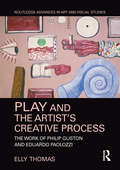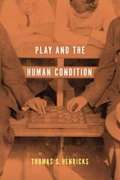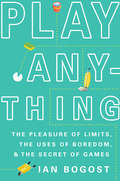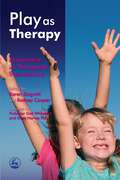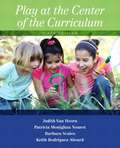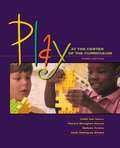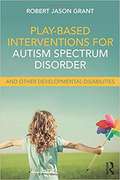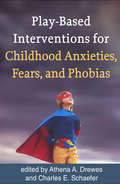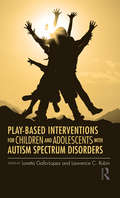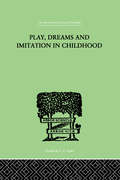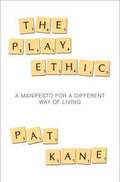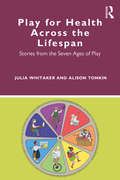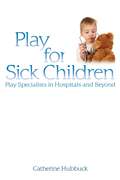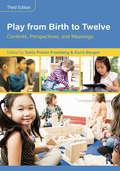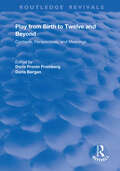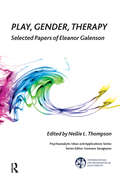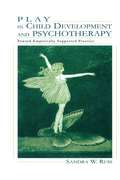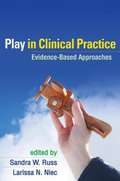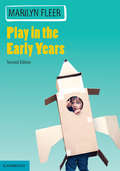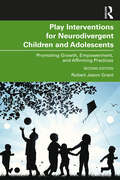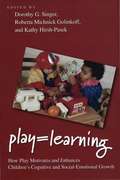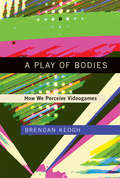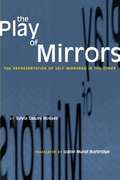- Table View
- List View
Play and the Artist’s Creative Process: The Work of Philip Guston and Eduardo Paolozzi (Routledge Advances in Art and Visual Studies)
by Elly ThomasPlay and the Artist’s Creative Process explores a continuity between childhood play and adult creativity. The volume examines how an understanding of play can shed new light on processes that recur in the work of Philip Guston and Eduardo Paolozzi. Both artists’ distinctive engagement with popular culture is seen as connected to the play materials available in the landscapes of their individual childhoods. Animating or toying with material to produce the unforeseen outcome is explored as the central force at work in the artists’ processes. By engaging with a range of play theories, the book shows how the artists’ studio methods can be understood in terms of game strategies.
Play and the Human Condition
by Thomas S. HenricksIn Play and the Human Condition, Thomas Henricks brings together ways of considering play to probe its essential relationship to work, ritual, and communitas. Focusing on five contexts for play--the psyche, the body, the environment, society, and culture--Henricks identifies conditions that instigate play, and comments on its implications for those settings. Offering a general theory of play as behavior promoting self-realization, Henricks articulates a conception of self that includes individual and social identity, particular and transcendent connection, and multiple fields of involvement. Henricks also evaluates play styles from history and contemporary life to analyze the relationship between play and human freedom. Imaginative and stimulating, Play and the Human Condition shows how play allows us to learn about our qualities and those of the world around us--and in so doing make sense of ourselves.
Play Anything: The Pleasure of Limits, the Uses of Boredom, and the Secret of Games
by Ian BogostHow filling life with play-whether soccer or lawn mowing, counting sheep or tossing Angry Birds-forges a new path for creativity and joy in our impatient ageLife is boring: filled with meetings and traffic, errands and emails. Nothing we'd ever call fun. But what if we've gotten fun wrong? In Play Anything, visionary game designer and philosopher Ian Bogost shows how we can overcome our daily anxiety; transforming the boring, ordinary world around us into one of endless, playful possibilities.The key to this playful mindset lies in discovering the secret truth of fun and games. Play Anything, reveals that games appeal to us not because they are fun, but because they set limitations. Soccer wouldn't be soccer if it wasn't composed of two teams of eleven players using only their feet, heads, and torsos to get a ball into a goal; Tetris wouldn't be Tetris without falling pieces in characteristic shapes. Such rules seem needless, arbitrary, and difficult. Yet it is the limitations that make games enjoyable, just like it's the hard things in life that give it meaning.Play is what happens when we accept these limitations, narrow our focus, and, consequently, have fun. Which is also how to live a good life. Manipulating a soccer ball into a goal is no different than treating ordinary circumstances- like grocery shopping, lawn mowing, and making PowerPoints-as sources for meaning and joy. We can "play anything" by filling our days with attention and discipline, devotion and love for the world as it really is, beyond our desires and fears.Ranging from Internet culture to moral philosophy, ancient poetry to modern consumerism, Bogost shows us how today's chaotic world can only be tamed-and enjoyed-when we first impose boundaries on ourselves.
Play as Therapy: Assessment and Therapeutic Interventions
by Steve Harvey Judi Parson Virginia Ryan Jennifer Sturgess Susan Esdaile Rachael Mcdonald Anita Bundy Reinie Cordier Athena Drewes Tina Lautaumo Gail Whiteford Ann Cattanach Karen Stagnitti Ted Brown Rodney CooperWhile paediatric healthcare professionals view play as the treatment tool of choice for children under school age, the theory and practice underpinning play-based therapeutic approaches often remain less clear to individual practitioners. Paediatric intervention approaches are increasingly being questioned, and individual practitioners constantly asked to provide evidence-based practice. In response, a more coherent understanding and fresh discussion on children's play and utilisation of play for therapeutic purposes is needed, especially as societal expectations and lifestyles change. Play as Therapy provides background theory and practical applications of original research on play assessment and interventions used in therapy. The book offers a solid foundation for identifying and assessing play dysfunction, understanding play in different cultural contexts and considerations when intervening with play. The practical approach is underpinned by theory, research and case vignettes to explain how to utilise play as therapy with challenging children.
Play at the Center of the Curriculum
by Judith Van Hoorn Patricia Monighan Nourot Barbara Scales Keith Rodriguez AlwardThe leading text in the field, Play at the Center of the Curriculum seamlessly combines the features of a text on play and development with the features of an early childhood curriculum text to present a comprehensive, cogent rationale for placing play at the center of a balanced curriculum. Ideal for those who want to engage children in a developmental zone where children and teachers are learning from and with each other, the authors put play at the center of a balanced curriculum that includes spontaneous, guided, and directed play as well as teacher planned instruction. They describe how knowledgeable teachers use a wide repertoire of strategies to orchestrate the flow from spontaneous play to guided play, to more subject oriented instruction, and back to play. This thoroughly updated Sixth Edition interweaves anecdotes of children’s play, theories of play and development, empirical evidence from research, and practical instructional strategies to give students a clear look at play and the curriculum.
Play at the Center of the Curriculum
by Judith Van Hoorn Patricia Monighan Nourot Barbara Scales Keith Rodriquez AlwardThis book for future early childhood educators offers all of the background needed to plan and implement a developmentally appropriate, play-centered curriculum for children ages 3 to 8.
Play-Based Interventions for Autism Spectrum Disorder and Other Developmental Disabilities
by Robert Jason GrantPlay-Based Interventions for Autism Spectrum Disorder and Other Developmental Disabilities contains a wide selection of play therapy interventions for use with children and adolescents with autism spectrum disorders, dysregulation issues, or other neurodevelopmental disorders. <P><P>The structured interventions focus on improvement in social skills, emotional regulation, connection and relationship development, and anxiety reduction. Special considerations for implementing structured interventions and an intervention tracking sheet are also presented. <P><P>This valuable tool is a must have for both professionals and parents working on skill development with these populations.
Play-Based Interventions for Childhood Anxieties, Fears, and Phobias
by Athena A. Drewes Charles E. SchaeferIllustrating the power of play for helping children overcome a wide variety of worries, fears, and phobias, this book provides a toolkit of play therapy approaches and techniques. Coverage encompasses everyday fears and worries in 3- to 12-year-olds as well as anxiety disorders and posttraumatic problems. Leading practitioners describe their approaches step by step and share vivid illustrative case material. Each chapter also summarizes the research base for the interventions discussed. Key topics include adapting therapy to each child's developmental level, engaging reluctant or less communicative clients, and involving parents in treatment.
Play-Based Interventions for Children and Adolescents with Autism Spectrum Disorders
by Lawrence C. Rubin Loretta Gallo-LopezPlay-Based Interventions for Children and Adolescents with Autism Spectrum Disorders explores the most recognized, researched, and practical methods for using play therapy with the increasing number of children diagnosed with Autism Spectrum Disorders (ASDs), and shows clincians how to integrate these methods into their practices. Using a diverse array of play-based approaches, the book brings together the voices of researchers and practicing clinicians who are successfully utilizing play and play-based interventions with children and adolescents on the autism spectrum. It also examines the neurobiological underpinnings of play in children on the autism spectrum and the overall effect of play on neuro-typical and neuro-atypical development. Finally, through careful integration of theory with real-world clinical case application, each chapter also shows clinicians how to incorporate a particular treatment approach and make it a viable and effective part of their work with this challenging clinical population.
Play, Dreams And Imitation In Childhood
by Piaget, JeanFirst published in 1999. Routledge is an imprint of Taylor & Francis, an informa company.
The Play Ethic: A Manifesto for a Different Way of Living
by Pat KaneThe Play Ethic explores the real meaning of play and shows how a more playful society would revolutionize and liberate our daily lives. Using wide and varied sources from the Enlightenment to Eminem, Socrates to Chaos theory, Kierkegaard to Karaoke, this book shows how play is fundamental to both society and to the individual, and how the work ethic that has dominated the last three centuries is ill-equipped to deal with the modern world.
Play for Health Across the Lifespan: Stories from the Seven Ages of Play
by Julia Whitaker Alison TonkinPlay for Health Across the Lifespan uses case studies to explore the impact of play and creativity on health and wellbeing throughout the lifecycle. While play at the start of life influences future development, the authors show play also has a role in improving prospects for health and wellbeing in adulthood and later life. A relational approach to health and wellbeing emphasizes the dynamic, mutually influential relationship between individual development and the changing contexts of our lives. Our personal play history is one feature of this dynamic process, and this book explores how the experience of play throughout the life course sculpts and resculpts the shape of our lives: our physical health, our mental wellbeing, and our relationship to the people and the world around us. Storytelling has been used since the beginning of time to communicate important life lessons in an engaging way. Taking inspiration from Shakespeare’s ‘Seven Ages of Man’, the book uses a case-story approach to differentiate the stages of development and to present evidence for how play and playful experiences impact on health and wellbeing from birth to the end of life in the context of temporal and situational change. Each chapter in Play for Health Across the Lifespan introduces relevant evidence-based research on play and health, before presenting several narrative ‘case stories’, which illustrate the application of play theory and the neuroscience of play as they relate to each life stage. With contributions from specialists in health and education, community organizations and the creative and performing arts, this book will appeal to academics, students, and practitioners who are interested in exploring the role of play in addressing contemporary challenges to our physical, mental, and social health.
Play for Sick Children: Play Specialists in Hospitals and Beyond
by Cath HubbuckPlay for Sick Children offers a unique insight into the crucial work of the play specialist. It examines the repercussions of being ill and receiving treatment experienced by children and their families, and highlights the importance of receiving quality play opportunities to counter these negative effects. The author proposes that play should be a high priority for those working in hospitals and other healthcare settings, and challenges other professionals to acknowledge, understand, accept and value the play specialist's role within the multidisciplinary team. The book explores the history of play in hospital, outlines the basic techniques and practical approaches used in working with sick children and young people, and identifies and discusses key theoretical and practical elements of the ever-changing role of the play specialist. This all-encompassing resource will be of great value to the ever growing and dedicated community of professionals who provide play, information and emotional support for sick children and their families.
Play from Birth to Twelve: Contexts, Perspectives, and Meanings
by Doris Pronin Fromberg and Doris BergenIn light of recent standards-based and testing movements, the issue of play in child development has taken on increased meaning for educational professionals and social scientists. This third edition of Play From Birth to Twelve offers comprehensive coverage of what we now know about play and its guiding principles, dynamics, and importance in early learning. These up-to-date essays, written by some of the most distinguished experts in the field, help educators, psychologists, anthropologists, parents, health service personnel, and students explore a variety of theoretical and practical ideas, such as: all aspects of play, including historical and diverse perspectives as well as new approaches not yet covered in the literature how teachers in various classroom situations set up and guide play to facilitate learning how play is affected by societal violence, media reportage, technological innovations, and other contemporary issues play and imagination within the current scope of educational policies, childrearing methods, educational variations, cultural differences, and intellectual diversity New chapters in the third edition of Play From Birth to Twelve cover current and projected future developments in the field of play, such as executive function, neuroscience, autism, play in museums, "small world" play, global issues, media, and technology. The book also suggests ways to support children’s play across different environments at home, in communities, and within various institutional settings.
Play from Birth to Twelve: Contexts, Perspectives, and Meanings
by Doris Pronin FrombergFirst published in 1998. Play is pervasive, infusing human activity throughout the life span. In particular, it serves to characterize childhood, the period from birth to age twelve. Within the past twenty years, many additions to the knowledge base on childhood play have been published in popular and scholarly literature. This book assembles and integrates this information, discusses disparate and diverse components, highlights the underlying dynamic processes of play, and provides a forum from which new questions may emerge and new methods of inquiry may develop. The place of new technologies and the future of play in the context of contemporary society also are discussed.
Play, Gender, Therapy: Selected Papers of Eleanor Galenson (The International Psychoanalytical Association Psychoanalytic Ideas and Applications Series)
by Nellie L. ThompsonEleanor Galenson had a remarkable career whose singular focus was her life-long interest in the maturational and psychosexual vicissitudes of infancy and early childhood. The selection of her writings in this volume highlight her approach to the study of the early years of life and, in particular, her contributions to understanding the developmental significance of the very young child's discovery of sexual difference, and the ways in which each child expresses this through play, symbolization and language. Interviews that Galenson gave to Milton Senn and Lucy LaFarge provide a Prologue to the Volume. They introduce the reader to her voice, and portray the milieu within which she matured and worked as a pediatrician, researcher and psychoanalyst. Papers are organized in three parts that illustrate different facets of Galenson's thinking and work: Symbolization, Thought and Language; Infantile Origins of Sexual Identity; and The Tripartite Therapeutic Model. Parts 1 and 2 are introduced by Patricia Nachman and Lucy LaFarge, respectively, colleagues and friends of Galenson who are deeply familiar with her work.
Play in Child Development and Psychotherapy: Toward Empirically Supported Practice
by Sandra Walker RussChild psychotherapy is in a state of transition. On the one hand, pretend play is a major tool of therapists who work with children. On the other, a mounting chorus of critics claims that play therapy lacks demonstrated treatment efficacy. These complaints are not invalid. Clinical research has only begun. Extensive studies by developmental researchers have, however, strongly supported the importance of play for children. Much knowledge is being accumulated about the ways in which play is involved in the development of cognitive, affective, and personality processes that are crucial for adaptive functioning. However, there has been a yawning gap between research findings and useful suggestions for practitioners. Play in Child Development and Psychotherapy represents the first effort to bridge the gap and place play therapy on a firmer empirical foundation. Sandra Russ applies sophisticated contemporary understanding of the role of play in child development to the work of mental health professionals who are trying to design intervention and prevention programs that can be empirically evaluated. Never losing sight of the complex problems that face child therapists, she integrates clinical and developmental research and theory into a comprehensive, up-to-date review of current approaches to conceptualizing play and to doing both therapeutic play work with children and the assessment that necessarily precedes and accompanies it.
Play in Clinical Practice
by Sandra Russ Larissa NiecGoing beyond traditional play therapy, this innovative book presents a range of evidence-based assessment and intervention approaches that incorporate play as a key element. It is grounded in the latest knowledge about the importance of play in child development. Leading experts describe effective strategies for addressing a wide variety of clinical concerns, including behavioral difficulties, anxiety, parent child relationship issues, trauma, and autism. The empirical support for each approach is summarized and clinical techniques are illustrated. The book also discusses school-based prevention programs that utilize play to support children's learning and social-emotional functioning.
Play in the Early Years
by Marilyn FleerThe Early Years Learning Framework is a key component of the Australian Government's National Quality Framework for early childhood education and care. Play-based learning is an important focus in both the Framework and in early childhood education degrees at Australian universities. Play in the Early Years is a comprehensive study of pedagogy and play in early childhood education by a globally recognised leader in the field. Marilyn Fleer examines how play has been thought about across time, culture and institutions, including in childcare, family day care, schools and community groups. The book presents and analyses the latest research and theories about early childhood pedagogy and play. Vignettes and real-world examples help students connect theory to practice, while end-of-chapter glossaries help to consolidate understanding of key concepts and ideas. This is an accessible and engaging textbook that will be an invaluable resource for practitioners and undergraduate students of early childhood education.
Play in the Early Years
by Marilyn FleerThe Early Years Learning Framework is a key component of the Australian Government's National Quality Framework for early childhood education and care. Play-based learning is an important focus in both the Framework and in early childhood education degrees at Australian universities. Play in the Early Years is a comprehensive study of pedagogy and play in early childhood education by a globally recognised leader in the field. Marilyn Fleer examines how play has been thought about across time, culture and institutions, including in childcare, family day care, schools and community groups. The book presents and analyses the latest research and theories about early childhood pedagogy and play. Vignettes and real-world examples help students connect theory to practice, while end-of-chapter glossaries help to consolidate understanding of key concepts and ideas. This is an accessible and engaging textbook that will be an invaluable resource for practitioners and undergraduate students of early childhood education.
Play Interventions for Neurodivergent Children and Adolescents: Promoting Growth, Empowerment, and Affirming Practices
by Robert Jason GrantThis revamped second edition provides several play interventions designed to address a variety of common mental health needs that neurodivergent children face, such as social navigation, regulation, relationship development, anxiety issues, identity struggles, and self-advocacy. Completely reorganized and with the addition of several new chapters, the book begins with a thorough presentation of how and why structured interventions are used with neurodivergent children. Special focus is given to understanding neurodivergence, relationship and rapport building, therapy planning and goal setting, how to create a structured play intervention, the therapeutic powers of play, the role and level of involvement of the therapist, theory integration, avoiding ableist practices, and parent involvement. The second half of the book covers a wide selection of play therapy interventions for use with neurodivergent children and adolescents. The structured interventions focus on need areas related to social navigation, emotional expression, regulation, sensory processing, connection and relationship development, executive functioning, strengths, self-advocacy, and identity. These structured play therapy interventions designed uniquely for neurodivergent children and adolescents will be valuable resources for any mental health professional working with neurodivergent youth.
Play = Learning: How Play Motivates and Enhances Children's Cognitive and Social-Emotional Growth
by Roberta Michnick Golinkoff Kathy Hirsh-Pasek Dorothy G. SingerWhy is it that the best and brightest of our children are arriving at college too burned out to profit from the smorgasbord of intellectual delights that they are offered? Why is it that some preschools and kindergartens have a majority of children struggling to master cognitive tasks that areinappropriate for their age? Why is playtime often considered to be time unproductively spent?In Play=Learning, top experts in child development and learning contend that the answers to these questions stem from a single source: in the rush to create a generation of Einsteins, our culture has forgotten about the importance of play for children's development. Presenting a powerful argumentabout the pervasive and long-term effects of play, Singer, Golinkoff, and Hirsh-Pasek urge researchers and practitioners to reconsider the ways play facilitates development across domains. Over forty years of developmental research indicates that play has enormous benefits to offer children, not theleast of which is physical activity in this era of obesity and hypertension. Play provides children with the opportunity to maximize their attention spans, learn to get along with peers, cultivate their creativity, work through their emotions, and gain the academic skills that are the foundation forlater learning. Using a variety of methods and studying a wide range of populations, the contributors to this volume demonstrate the powerful effects of play in the intellectual, social, and emotional spheres. Play=Learning will be an important resource for students and researchers in developmental psychology. Its research-based policy recommendations will be valuable to teachers, counselors, and school psychologists in their quest to reintroduce play and joyful learning into our school rooms and livingrooms.
Play, Learning, and Children's Development
by Mariane Hedegaard Marilyn FleerThis book explores the dynamics in children's everyday lives as they move between school and the family, with particular consideration of how children's motives change in response new challenges. Professors Mariane Hedegaard and Marilyn Fleer follow four children, two from Australia and two from Denmark, over a twelve-month period. Using these case studies, they show how children's everyday activities, play, and the demands of both family and educational contexts influence their learning and development. The authors contribute to a sociocultural theory formulation that includes the child's perspective in cultural historical contexts. Their approach yields insights that transcend specific nationalities, cultures, and socioeconomic situations. The analysis shows not just how children's family life shapes their experiences in school, but how schools influence and shape their lives at home.
A Play of Bodies: How We Perceive Videogames (The\mit Press Ser.)
by Brendan KeoghAn investigation of the embodied engagement between the playing body and the videogame: how player and game incorporate each other.Our bodies engage with videogames in complex and fascinating ways. Through an entanglement of eyes-on-screens, ears-at-speakers, and muscles-against-interfaces, we experience games with our senses. But, as Brendan Keogh argues in A Play of Bodies, this corporal engagement goes both ways; as we touch the videogame, it touches back, augmenting the very senses with which we perceive. Keogh investigates this merging of actual and virtual bodies and worlds, asking how our embodied sense of perception constitutes, and becomes constituted by, the phenomenon of videogame play. In short, how do we perceive videogames?Keogh works toward formulating a phenomenology of videogame experience, focusing on what happens in the embodied engagement between the playing body and the videogame, and anchoring his analysis in an eclectic series of games that range from mainstream to niche titles. Considering smartphone videogames, he proposes a notion of co-attentiveness to understand how players can feel present in a virtual world without forgetting that they are touching a screen in the actual world. He discusses the somatic basis of videogame play, whether games involve vigorous physical movement or quietly sitting on a couch with a controller; the sometimes overlooked visual and audible pleasures of videogame experience; and modes of temporality represented by character death, failure, and repetition. Finally, he considers two metaphorical characters: the “hacker,” representing the hegemonic, masculine gamers concerned with control and configuration; and the “cyborg,” less concerned with control than with embodiment and incorporation.
The Play of Mirrors: The Representation of Self Mirrored in the Other
by Caiuby Novaes SylviaFocusing on the Bororo people of west-central Brazil, this book addresses the construction of self-identity through interethnic interaction. By presenting the images the Bororo have of themselves as well as the images of others who have interacted with them, Brazilian anthropologist Sylvia Caiuby Novaes argues convincingly that Bororo self-images are constructed with the aid of a peculiar looking-glass--it is in the images of others that they see themselves.<P><P>Incorporating contributions from psychology, psychoanalysis, linguistics, and semiotics, Play of Mirrors focuses on symbols, images, discourse, and meanings rather than solely on the problem of acculturation. It thus reflects the thinking of a new generation of Brazilian anthropologists who have shifted their focus from native communities as isolated entities to an examination of their embeddedness within broader national and international arenas.
